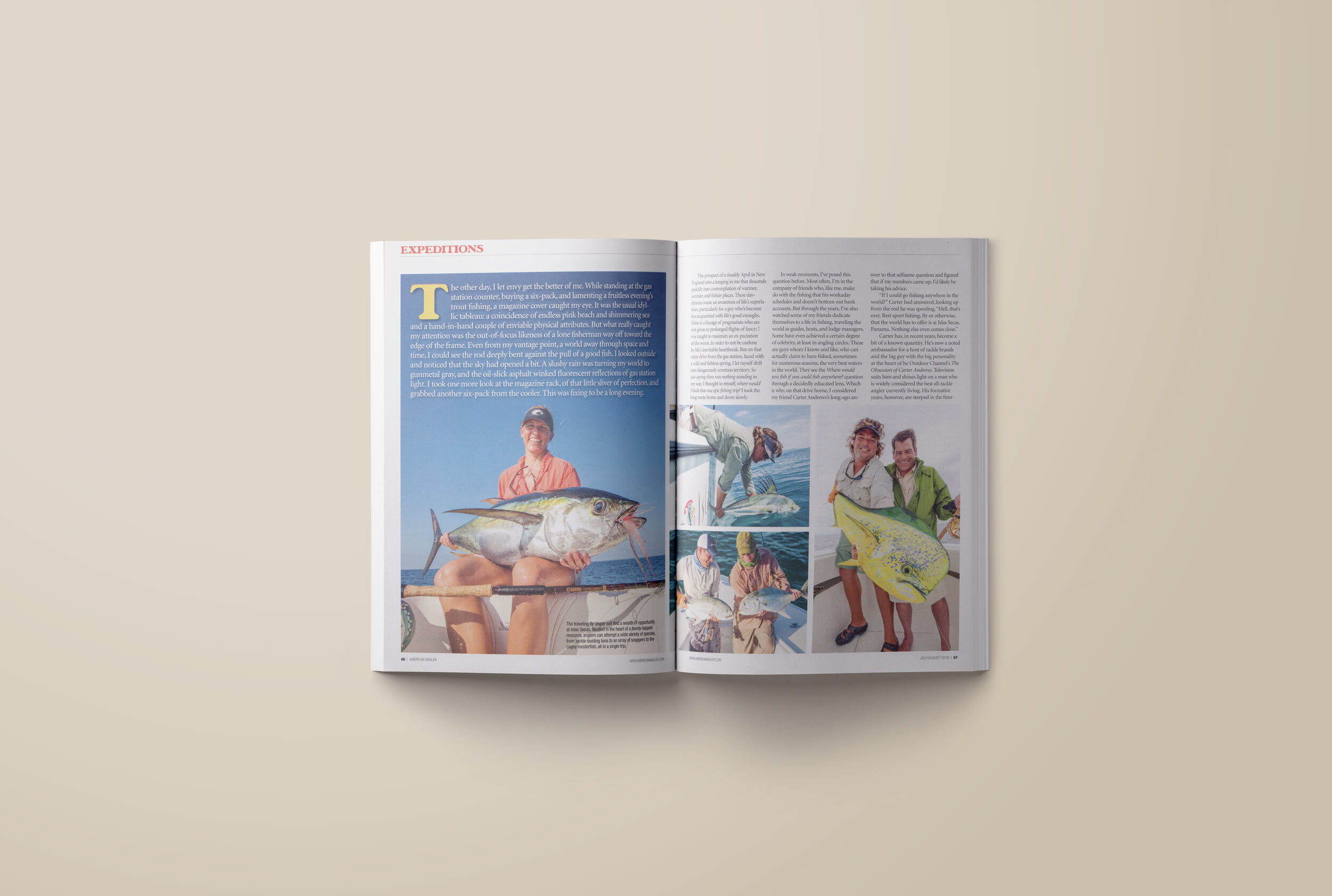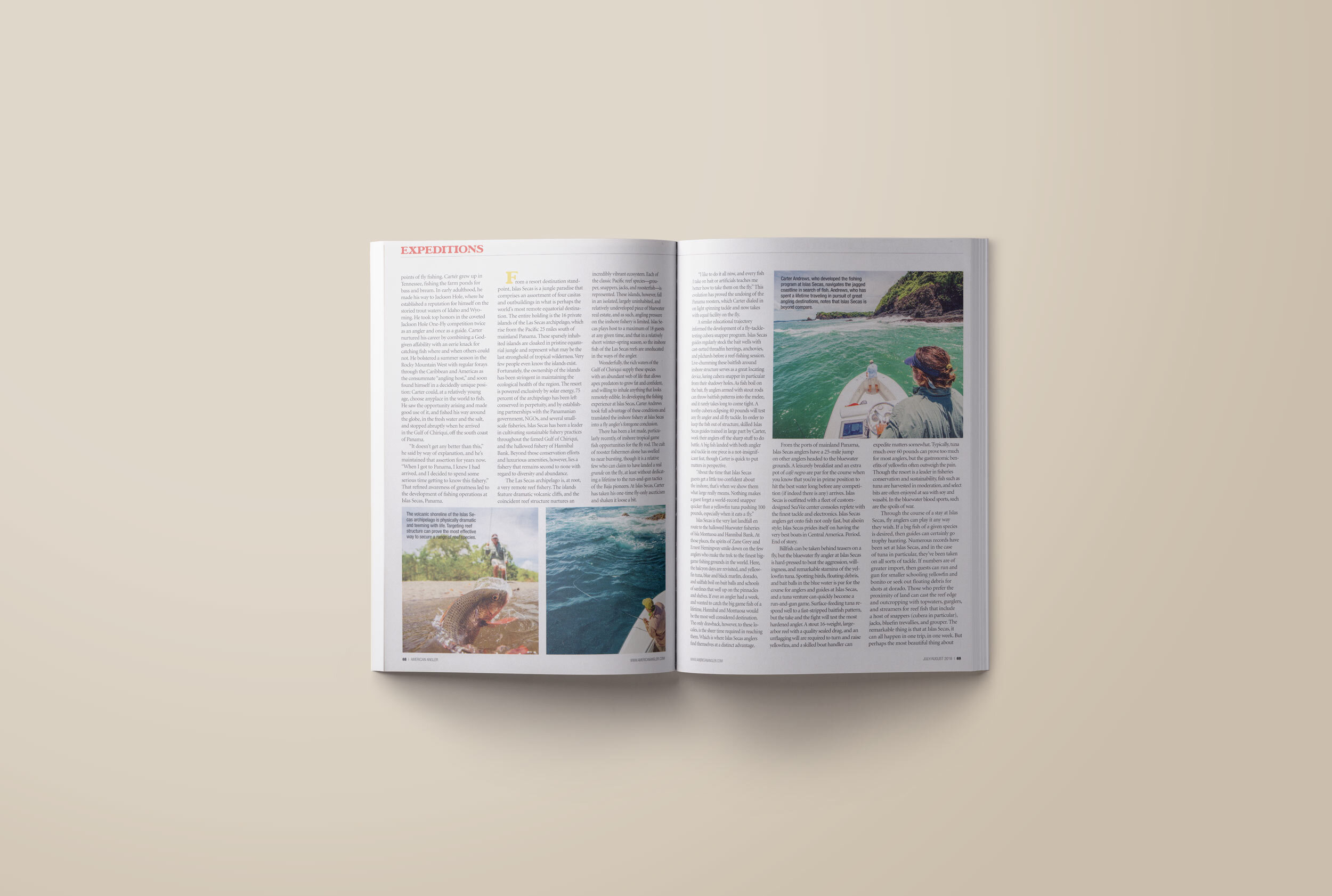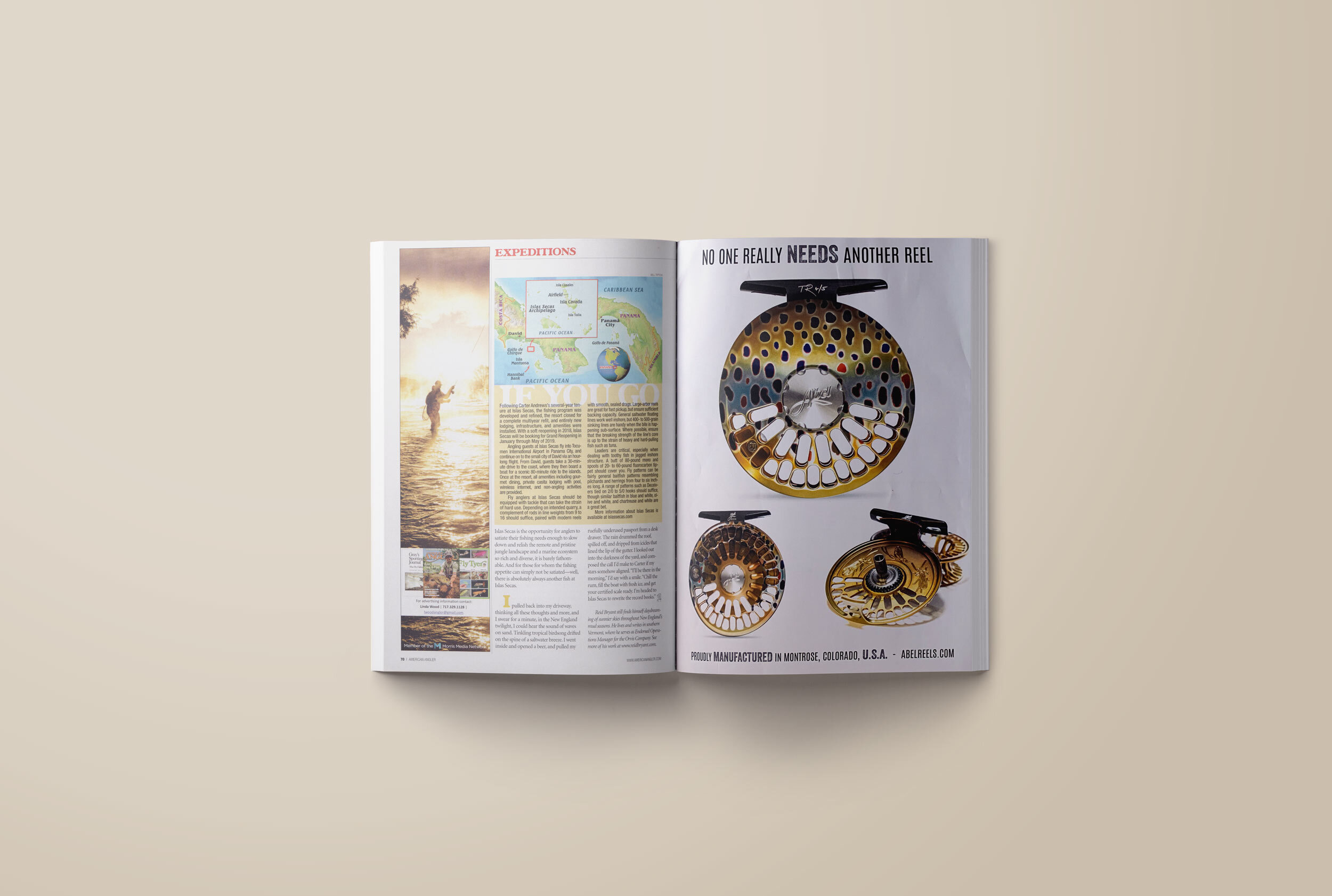The Stuff of Dreams
The other day, I let envy get the better of me. I was standing at the gas station counter, buying a six-pack and lamenting a fruitless evening’s trout fishing, when a magazine cover caught my eye. It was the usual idyllic tableau: a coincidence of endless pink beach and shimmering sea and a hand-in-hand couple of enviable physical attributes. But what really got me was the out-of-focus likeness of a lone fisherman way off towards the edge of the frame. Even from my vantage point, a world away through space and time, I could see his rod deeply bent against the pull of a good fish. I looked outside and noticed that the sky had opened a bit in the April evening. A slushy rain was turning my world to gunmetal grey, and the oil-slick asphalt winked fluorescent reflections of gas-station light. I took one more look at the magazine rack, of that little sliver of perfection, and grabbed another six-pack from the cooler. This was fixing to be a long evening.
The prospect of a New England mud season stirs a longing in me that descends quickly into contemplation of warmer, and sunnier, and fishier places. These daydreams rouse an awareness of life’s superlatives, particularly for a guy who’s become well acquainted with life’s good enough’s. Mine is a lineage of pragmatists who are not given to prolonged flights of fancy; I was long ago taught that one should maintain an expectation of the worst, in order to not be undone by life’s inevitable heartbreak. But on that rainy drive home from the gas station, faced with a cold and fishless Spring, I let myself drift into dangerously covetous territory. “So just saying there was nothing standing in my way,” I thought to myself, “where would I book that one epic fishing trip?” Needless to say I took the long route home, and drove slowly.
In weak moments, I’ve posed this question before. Most often, I’m in the company of friends who, like me, make do with the fishing that fits workaday schedules and doesn’t bottom out bank accounts. But through the years I’ve also watched some of my friends dedicate themselves to a life in fishing, traveling the world as guides, hosts, and lodge managers. Some have even achieved a certain degree of celebrity, at least in angling circles. These are guys that I know and like, who can actually claim to have fished, sometimes for numerous seasons, the very best waters in the world. They see the “where would you fish if you could fish anywhere?” question through a decidedly educated lens. Which is why, on that drive home, I considered my friend Carter Andrews’ long ago answer to that self-same question, and figured that if my numbers came up, I’d likely be taking his advice.
“If I could go fishing anywhere in the world?” Carter had answered, looking up from the reel he was spooling. “Hell, that’s easy. Best sport-fishing, fly or otherwise, that the world has to offer is at Islas Secas, Panama. Nothing else even comes close.”
Carter has, in recent years, become a bit of a known quantity. He’s now a noted ambassador for a host of tackle brands, and the big guy with the big personality at the heart of The Outdoor Channel’s The Obsession of Carter Andrews. Television suits him, and shines a light on a man who is widely considered the best all-tackle angler currently living. His formative years, however, are steeped in the finer points of fly fishing. Carter grew up in Tennessee, fishing the farm ponds for bass and bream. In early adulthood made his way to Jackson Hole, where he established a reputation for himself on the storied trout waters of Idaho and Wyoming. He took top honors in the coveted Jackson Hole One Fly competition twice as an angler, and once as a guide. Carter nurtured his career by combining a God-given affability with an eerie knack for catching fish where and when others could not. He bolstered a summer season in the Rocky Mountain West with regular forays through the Caribbean and Americas as the consummate ‘angling host’, and soon found himself in a decidedly unique position: Carter could, at a relatively young age, choose anyplace in the world to fish. He saw the opportunity arising and made good use of it, and fished his way around the globe, in the freshwater and the salt, and stopped abruptly when he arrived in the Gulf of Chiriqui, off the south coast of Panama. “It doesn’t get any better than this,” he said by way of explanation, and he’s maintained that assertion for years now. “When I got to Panama, I knew I had arrived, and I decided to spend some serious time getting to know this fishery.” That refined awareness of greatness led to the development of fishing operations at Islas Secas, Panama.
From a resort destination standpoint, Islas Secas is a jungle paradise that comprises an assortment of four casitas and outbuildings in what is perhaps the world’s most remote equatorial destination. The entire holding is the sixteen private islands of the Las Secas archipelago, which rise from the Pacific twenty-five miles south of mainland Panama. These sparsely inhabited islands are cloaked in pristine equatorial jungle, and represent what may be the last stronghold of tropical wilderness. Very few people even know the islands exist. Fortunately, the ownership of the islands has been stringent in maintaining the ecological health of the region. The resort is powered exclusively by solar energy, 75% of the archipelago has been left conserved in perpetuity, and by establishing partnerships with the Panamanian Government, NGO’s, and several small-scale fisheries, Islas Secas has been a leader in cultivating sustainable fishery practices throughout the famed Gulf of Chiriqui, and the hallowed fishery of Hannibal Bank. Beyond these conservation efforts and luxurious amenities, however, lies a fishery that remains second to none with regard to diversity and abundance.
The Las Secas archipelago is, at root, a very remote reef fishery. The islands feature dramatic volcanic cliffs, and the coincident reef structure nurtures an incredibly vibrant ecosystem. Each of the classic Pacific reef species is represented, most notably grouper, snapper, jacks, and roosterfish. However, these islands fall in an isolated, largely uninhabited, and relatively undeveloped piece of blue-water real estate, and as such, angling pressure on the inshore fishery is limited. Islas Secas only plays host to a maximum of eighteen guests at any given time, and that in a relatively short Winter/Spring season, so the inshore fish of the Las Secas reefs are uneducated in the ways of the angler. Wonderfully, the rich waters of the Gulf of Chiriqui supply these species with an abundant web of life upon which apex predators grow fat, and confident, and willing to inhale anything that looks remotely edible. In developing the fishing experience at Islas Secas, Carter Andrews took full advantage of these conditions, and translated the inshore fishery at Islas Secas into a fly angler’s foregone conclusion.
There has been a lot made, particularly recently, of inshore tropical game-fish opportunities for the fly rod. The cult of rooster-fishermen alone has swelled to near bursting, though it is a relative few who can claim to have landed a real Grande on the fly, at least without dedicating a lifetime to the run-and-gun tactics of the Baja pioneers. At Islas Secas, Carter has taken his onetime fly-only asceticism and shaken it loose a bit. “I like to do it all now, and every fish I take on bait or artificials teaches me better how to take them on the fly.” This evolution has proven the undoing of the Panama roosters, which Carter dialed in on light spinning tackle, and now takes with equal facility on the fly.
A similar educational trajectory informed the development of a fly-tackle-testing cubera snapper program. Islas Secas guides regularly stock the bait wells with cast-netted threadfin herring, anchovies, and pilchards before a reef-fishing session. Live-chumming these baitfish around inshore structure serves as a great locating device, luring cubera snapper in particular from their shadowy holes. As fish boil on the bait, fly anglers armed with stout rods can throw baitfish patterns into the melee, and it rarely takes long to come tight. A toothy cubera eclipsing 40 pounds will test any fly angler, and all fly tackle. In order to keep the fish out of structure, skilled Islas Secas guides trained in large part by Carter, work their anglers off the sharp stuff to do battle. A big fish landed with both angler and tackle in one piece is a not-insignificant feat, though Carter is quick to put matters in perspective. “About the time that Islas Secas guests get a little too confident about the inshore, that’s when we show them what ‘large’ really means. Nothing makes a guest forget a world-record snapper quicker than a Yellowfin Tuna pushing 100 lb., especially when it eats a fly.”
Islas Secas is the very last landfall en route to the hallowed blue-water fisheries of Isla Montuosa and Hannibal Bank. At these places, the spirits of Zane Gray and Ernest Hemingway smile down on the lucky few anglers that make the trek to the finest big game fishing grounds in the world. Here, the halcyon days are revisited, and Yellowfin Tuna, Blue and Black Marlin, Dorado, and Sailfish boil on bait balls and schools of sardines that well up on the pinnacles and shelves. If ever an angler had a week, and wanted to catch the big game fish of a lifetime, Hannibal and Montuosa would be the most well-considered destination. The only drawback, however, to these locales, is the sheer time required in reaching them. Which is where Islas Secas anglers find themselves at a distinct advantage.
From the ports of mainland Panama, Islas Secas anglers have a twenty-five mile jump on other anglers headed to the blue-water grounds. A leisurely breakfast and an extra pot of Café Negro are par for the course when you know that you’re in prime position to hit the best water long before any competition (if indeed there is any) arrives. Islas Secas is outfitted with a fleet of custom-designed Sea Vee center consoles replete with the finest in tackle and electronics. Not only do Islas Secas anglers get onto fish fast, they get onto them in style; Islas Secas prides itself on having the very best boats in Central America. Period. End of story.
Though fly-rod billfish can be taken behind teasers, the blue-water fly angler at Islas Secas is hard pressed to beat the aggression, willingness, and remarkable stamina of the yellowfin tuna. Spotting birds, floating debris, and bait balls in the blue water is par for the course for anglers and guides at Islas Secas, and a tuna venture can quickly become a run-and-gun game. Surface feeding tuna respond well to a fast-tripped baitfish pattern, but the take and the fight will test the most hardened angler. A stout 16 wt. rod, a large-arbor reel with a quality sealed drag, and an unflagging will are required to turn and raise yellowfins, and a skilled boat handler can expedite matters somewhat. Typically, tuna much over the 60 pound threshold can prove too much for most anglers, but the gastronomic benefits of yellowfin often outweigh the pain. Though the resort is a leader in fisheries conservation and sustainability, fish such as tuna are harvested in moderation, and select bits are often enjoyed at sea with soy and wasabi. In the blue water blood sports, such are the spoils of war.
Through the course of a stay at Islas Secas, fly anglers can play it any way they wish. If a big fish of a given species is desired, then guides can certainly go trophy hunting. Numerous records have been set at Islas Secas, and, in the case of tuna in particular, they’ve been taken on all sorts of tackle. If numbers are of greater import, then guests can run and gun for smaller schooling yellowfin and bonito or seek out floating debris for shots at dorado. Those who prefer the proximity of land can cast the reef edge and outcropping with top-waters, gurglers, and streamers for reef fish that include a host of snappers (Cubera in particular), jacks, bluefin trevally, and grouper. The remarkable thing is that at Islas Secas, it can all happen in one trip, in one week. But perhaps the most beautiful thing about Islas Secas is the opportunity for anglers to satiate their fishing needs enough to slow down and relish the remote and pristine jungle landscape, and a marine ecosystem so rich and diverse it is barely fathomable. And for those for whom the fishing appetite can simply not be whet, well there is absolutely always another fish at Islas Secas.
I pulled back into my driveway the other night thinking all of these thoughts and more, and I swear for a minute, in the New England twilight, I could hear the sound of waves on sand. Tinkling tropical birdsong drifted through the pines, on the spine of a saltwater breeze. I went inside and opened a beer, and pulled my ruefully underused passport from a desk drawer. The rain drummed the roof, spilled off, and dripped from icicles that lined the lip of the gutter. I looked out into the darkness of the yard, and composed the call I’d make to Carter if my stars somehow aligned. “I’ll be there in the morning,” I’d say with a smile. “Chill the rum, fill the boat with fresh ice, and get your certified scale ready. I’m headed to Islas Secas to re-write the record books.”
If You Go:
Following Carter Andrews’ several-year tenure at Islas Secas wherein the fishing program was developed and refined, the resort closed for a complete multi-year re-fit wherein entirely new lodging, infrastructure, and amenities were installed. With a soft re-opening in 2018, Islas Secas will be booking for Grand Re-opening in January-May of 2019.
Angling Guests at Islas Secas fly into Tocumen International Airport in Panama City, and continue on to the small city of David via an hour-long flight. From David, guests take a 30-minute drive to the coast where they then board a boat for a scenic 80-minute ride to the islands. Once at the resort, all amenities including gourmet dining, private casita lodging with pool, wireless internet, and non-angling activities are provided.
Fly anglers at Islas Secas should be equipped with tackle that can take the strain of hard use. Depending on intended quarry, a complement of rods in line weights from 9 to 16 should suffice, paired with modern reels with smooth, sealed drags. Large arbor reels are great for fast pick-up, but ensure sufficient backing capacity. General saltwater floating lines work well inshore, but 400-500 grain sinking lines are handy when the bite is happening sub-surface. Where possible ensure that the breaking strength of the line’s core is up to the strain of heavy and hard-pulling fish such as tuna.
Leaders are critical, especially when dealing with toothy fish in jagged inshore structure. A butt of 80 lb. mono and spools of 20-60 lb. fluorocarbon tippet should cover the range of situations fly anglers are likely to encounter. Fly patterns can be fairly general baitfish patterns resembling pilchards and herring from 4 to 6 inches long. A range of patterns such as Deceivers tied on 2/0 to 5/0 hooks should suffice, though similar baitfish in blue/white, olive/white, and chartreuse/white are a great bet.
More information about Islas Secas is available at https://islassecas.com



